When we first started the What’s New in Translation column in 2015, it was to offer readers a look at the incredible work done by writers, translators, and publishers all around the world. Gathering some of the most exciting publications coming out each month, the column featured regular reviews from trusted critical voices, giving the spotlight over to this great wealth of literary work. A lot has changed in the last decade; though English still reigns, we’ve seen the advocates of literary translation win a lot of battles as they seek to make our reading landscape a more various, inclusive, and interconnected space. As such, we now feel the need to extend our purview to include more of these brilliant voices, more of this innovative work, more of the insights and wonders that they bring. We are delighted to announce that our monthly column will now feature a greater number of titles —but with the same incisive critical insight that we’ve always aimed to bring.
From Argentinian horror to the latest from a Hungarian master of form, an intergenerational Greek tale to haiku interpretations, read below for a list of the ten most exciting books out in September.
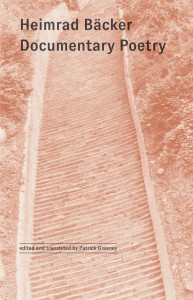
Documentary Poetry by Heimrad Bäcker, translated from the German by Patrick Greaney, Winter Editions, 2024
Review by Fani Avramopoulou
Documentary Poetry compiles a selection of German poet Heimrad Bäcker’s documentary poems and photographs with his published interviews, lectures, and essays, offering a richly contextualized introduction to his many decades of work documenting and reflecting on the Holocaust. Bäcker does not conceal his relation to the Nazi Party; he was an avid member for about a year, joining at the age of eighteen. He then denounced the Nazi ideology in the wake of the Nuremberg trials, and spent the rest of his life meticulously chronicling the Third Reich’s atrocities through photography and a poetic method he described as his “transcript system.” The collection’s title essay introduces what feels like the conceptual seed of Bäcker’s work: a reflection on the Nazis’ use of ordinary language to conceal, sanitize, enable, and systematize the horrors of the Holocaust. His conceptualization of language as a participatory, covert administrative tool of the Nazi ideological agenda leads to this development of the transcript system as a form of intervention—a way of undressing such language and purging it of its duplicities.
Bäcker’s creative and scholarly work continually circles the question of how the Nazis used language to translate previously unimaginable horrors into reality. In working through this, a second question is implied: how can we intervene on a linguistic level to prevent and impede present or future horrors? Working with original texts related to the Nazi Party and its crimes, Bäcker attempts to draw out the true, chilling meaning behind the curated surface of such language, using a concretizing docu-poetics that isolates and recombines pieces of original text, thus allowing the language to speak for itself in a fresh context. But beyond just acting as a demonstrative tool, his transcript system can also be seen as a model for disarming the sort of language that the Nazis employed. It offers us a mode of reflection—a way to stop and think, in Hannah Arendt’s framing—that eventually became for Bäcker a life-long practice toward reckoning with his own concrete support for a party that committed such unthinkable acts.
Translated and edited by Patrick Greaney, Documentary Poetry offers a generous introduction of Bäcker’s work to an English-speaking audience, joining a growing conversation about the role of poetry in how we remember, how we write history, and how we speak the future into existence.
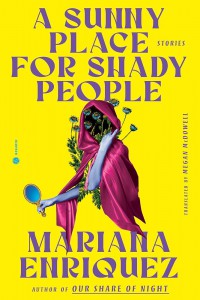
A Sunny Place for Shady People by Mariana Enriquez, translated from the Spanish by Megan Mcdowell, Hogarth, 2024
Review by Fani Avramopoulou
Argentine writer Mariana Enríquez, by now a major voice in contemporary literary horror, continues to prove the urgent relevance of the genre in A Sunny Place for Shady People, the latest collection of her stories to be translated into English by Megan McDowell. Like much of her earlier work, the stories in this collection lift the mask of our known world, finding horror in everyday forms of human cruelty and social neglect.
In one story, a community struggling with rampant violence is haunted by the ghost of a murdered teenager after they ignore his frantic knocking on the night of his death, having mistaken his pleas for a ploy. In another, a woman faces institutionalization after her erotic relationships with ghosts persist, despite a cocktail of psychiatric drugs pushed by her parents and doctors. The collection’s title story follows a reporter covering Elisa Lam’s tragic death at the Cecil Hotel in Los Angeles, a real case that produced a cult-like following and speculative media frenzy; during her visit to LA to report on the story, the narrator can’t stop thinking about her boyfriend Dizz, who died of an overdose a few years prior. He spent his final days just blocks away from the Cecil Hotel in Skid Row, a parallel that spotlights the ugly contrast between our cultural obsession with true crime and the everyday human suffering that is so often met with disdainful indifference.
The question of how we show up for one another (or not) haunts many of the characters in this collection. “What if I had been there?” asks the narrator of “My Sad Dead,” reflecting on the night of sixteen-year-old Matías’s murder, which left all of her neighbors complicit in the crime. “Would I have opened the door? Or would I have acted like all the others?” Emma is known in her community for her ability to communicate with the deceased. She attempts to soothe them where she can, advocates on their behalf, and helps her neighbors with their ghosts. She views this as her duty: “all of them, my sad dead, are my responsibility.” Enríquez’s stories take on a similar task, wielding the conventions of horror to reveal what already haunts us—or what should—and lets it speak.
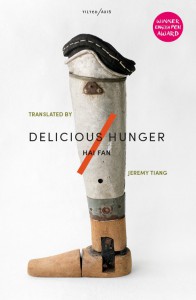
Delicious Hunger by Hai Fan, translated from the Chinese by Jeremy Tiang, Tilted Axis, 2024
Review by Henry Gifford
Two men meet in a hotel on the edge of the Malaysian rainforest. In a few days, they’ll be heading into the trees, joining the guerrillas of the Malayan Communist Party. Their comrades are fighting, dying, losing limbs and lovers, becoming heroes and martyrs—but mostly they’re surviving: hunting, trekking miles for water, hiding from or making peace with the elements. The men and women of “the Organization” have spent decades like this, waging a slow war for a cause they refuse to believe is lost. These two men can’t know exactly what’s waiting for them once they leave the hotel, but when one of them sees the other’s wooden flute among his belongings, he regards it with knowing contempt, then pulls out his revolver and slams it on the table: “This—is—the—only—thing—that—counts!”
Hai Fan, in the stories of Delicious Hunger, translated by Jeremy Tiang, is not sitting on either side of that table, arguing on behalf of one tool or the other. These tales stem from the years that Hai had spent with the MCP, and he’s very clear about the fact that they did not live by flutes alone; several stories include or end just before a gunfight, and you can’t win a gunfight without a gun. Yet, he’s also clear that there are plenty of other things that count. An illustrated glossary at the end of the book details the various types of equipment named throughout the stories; it describes tools used for cooking, sleep, and storage, but none for shooting.
What counts more still than any of that—and this is what the flute represents—is community. It’s not that old law about loving thy neighbor and keeping your hands off his stuff. It’s a political priority, framed here in terms of a revolutionary code of ethics, one based on generosity and sacrifice: “Losing your backpack is no big deal—the main thing is you saved communal property.” You might also call this duty, and there’s nothing inhumane or violent about it; it runs alongside the distinct human emotions that colour this collection. One of the stories is centered around how two comrades can become a couple: there’s no dating, but only a letter—written by one person, passed through the Organization, and “carefully considered” by the other. The process may seem odd, maybe sad, maybe backward; but even if it is subordinated to politics, Hai Fan suggests, there is still love in the Party.

Ginster by Siegfried Kracauer, translated from the German by Carl Skoggard, New York Review Books, 2024
Review by Henry Gifford
There’s nothing like a war to bring a people together, or to tear a person apart.
Siegfried Kracauer’s semi-autobiographical Ginster, published in Germany in 1928 and now available in an English translation by Carl Skoggard, begins at the very moment war is declared in 1914, and ends roughly with the armistice. In the novel, Kracauer’s eponymous alter-ego is a talented but unambitious young architect—shy, unhealthy, and lonely. His story is essentially a draft-dodging picaresque, the tale of a man trying by any means to avoid active duty. He succeeds first by joining the domestic medical corps, then by assisting with matériel production, until after a few months of training, he is finally let “off the hook” by a sympathetic ranking doctor. The reason for Ginster’s avoidance is simple and heretical to the nationalistic dogma: “I want to live.”
Kracauer knows himself well; Ginster is a superlatively well-realized character, a genuine individual with an unusual, amusing, and poignant worldview. The dozens of other people that populate the pages, on the other hand, are granted only a few defining characteristics. Thus Ginster’s fear of death is more than a desire to go on living; he sees death as the last in a line of threats to his individuality—considering a corpse, he thinks: “instead of ‘he’ one might as well say ‘it.’” These threats begin already in the first pages of the novel, with the war’s transformation of individuals into a nation, or a “folk”; they continue through the commodification of workers; and they reach their living apotheosis through a military that transforms its conscripts from human beings into automata, “rectangular box[es]” with limbs screwed in to march, salute, and fire. Ginster is heartbroken to see it happen to his beloved friend Otto, and terrified to find it happening to him.
These are vitally human concerns, but they’re especially dramatic in the militarized and mechanized young nation of Germany. The arm-bearing Ginster fears is German, and his individualism, too, is German, albeit of an older form.
Skoggard handles the challenge of translating such a local novel beautifully; we never forget where we are. German words are occasionally retained, but defined unobtrusively. Characters’ voices remain individuated, but not in such a way that they suggest a particular English-speaking type. When Ginster-Kracauer notes, “The whole of grammar had undergone a military transformation,” we believe it, and understand. It’s a tremendous achievement, worthy of this remarkable book.
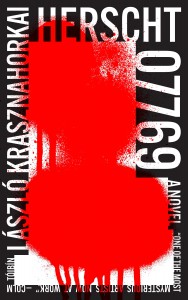
Herscht 07769 by László Krasznahorkai, translated from the Hungarian by Ottilie Mulzet, New Directions, 2024
Review by Christopher Higgs
Spoiler Alert: László Krasznahorkai’s latest dark cloudburst of a novel Herscht 07769, composed as a single four-hundred-and-thirty page sentence, challenges expectations in ways that new readers might find difficult or dubious—but which longtime fans of the experimental Hungarian novelist and screenwriter (widely respected for his collaborations with slow cinema filmmaker Béla Tarr) have long come to admire, adore, and appreciate; in particular, Krasznahorkai requires audiences to surrender to his pacing, his movement, his comportment, his breath, controlling time and attention through punctuation, and offering a world—which, this time, presents a small eastern German town called Kana, where a graffiti artist tags wolf emblems on various monuments to the composer Johann Sebastian Bach, and a gentle giant named Florian Herscht, employed by the Boss of a neo-Nazi group, as the person who cleans up the graffiti; Florian also fears the imminent collapse of the universe after attending a quantum physics lecture that unpacks the reality of nothingness, so he writes letters to Chancellor Angela Merkel to warn her of their impending doom, and all along Krasznahorkai keeps the people in this world moving like sludge melting down a long dirty window, or churning in a dust storm—they are both remembered and forgotten over and over, because when you enter one of the author’s books, it’s like parting a curtain and stepping into a slow tornado of images, ideas, thought patterns whirling and elliptical, ever transforming, misdirecting, stuttering, stumbling through cascading potential pathways jutting out in every direction—it’s like stepping into a river and becoming a paper boat, floating down a river that commands your movement with its currents, here poetically rendered by Ottilie Mulzet’s translation, and Krasznahorkai is that river, conducting the movement of attention, the direction of the sentence, the meticulously plotted introductions of information, character, setting, conflicts—because such elements do arise throughout Herscht 07769, but mostly in bursts and coagulations of seemingly discursive tangents, moving multi-directionally to create a vortex of intensification and thus reminding us of life’s nonlinearity, life’s messiness, life’s incoherency, and by foregrounding these formal choices, the novel thrives by evincing the value of how the story gets told, how the gentle giant of a sentence unfolds—showing us how the form carries as much meaning and significance as the story, and asking us to consider how the reading experience unfolds within our own thoughts and motions.
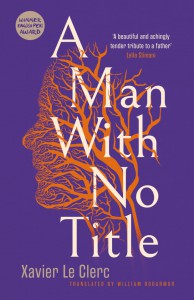
A Man With No Title by Xavier Le Clerc, translated from the French by William Rodarmor, Saqi Books, 2024
Review by Henry Gifford
Xavier Le Clerc’s A Man With No Title, translated by William Rodarmor, is an autobiographical novel in two parts—two men, two countries. The first part is a story of violence and extreme poverty, set in the Kabylian village of Bouhamza in northern Algeria in the 1940s. Life in Bouhamza for Mohand-Saïd Aït-Taleb (an iteration of Le Clerc’s own father) is defined by lack: lack of water, food, and the missing family members killed by disease and warfare. The second part continues through the eyes of Hamid, his son; it takes place in France, where Mohand-Saïd moves after the day his mother dies and Algeria gains independence, and here we see the man Mohand-Saïd becomes—a devoted and proud worker, a loving but distant father, a man alternately taciturn and enraged, like a hedgehog “curling up, out of fear.”
The border between these two parts isn’t clearly delineated. They are as entangled as a father’s life with his son’s, a man with the boy he once was, or a colony with its colonial ruler. In chapters that peer at history, we come to understand, with Hamid, that Mohand-Saïd’s anger and fear in France is a result of post-traumatic stress, a lifelong residue left by the poverty of his youth and the violence of the Algerian Civil War. Similar pains linger within the entire family, a haunting that manifests in their many unspoken stories.
The wounds of the past may always remain, but in France, Hamid finds a way to look forward. He translates his name into the French Xavier Le Clerc and loves his country without hesitation. No Algerian could be blind to France’s colonial crimes, but Le Clerc details his gratitude to the nation that helped feed and clothe him and his family. He is all the more grateful for the French language and literature, a tradition he is determined to place himself within. Alexandre Dumas, Albert Camus, and Annie Ernaux all make appearances throughout this family saga–cum-Künstlerroman, but the most suggestive evocation is of the greatest of them all; Mohand-Saïd’s memories, Le Clerc tells us, “weren’t Proustian madeleines. They were the shrapnel of poverty, fragments of childhood now lodged in my skull.” With this distinction, Le Clerc defines his literary project as an outgrowth of both the best and worst of France, a personal meditation on time and identity, but one intertwined with poverty, violence, and the long colonial hangover.
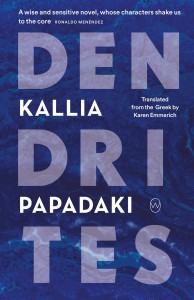
Dendrites by Kalia Papadaki, translated from the Greek by Karen Emmerich, World Editions, 2024
Review by Fani Avramopoulou
In the nervous system, a dendrite is a receiver, a point of contact. In geology, it is the branching path of a mineral as it migrates and breaks off from its point of origin. The word comes from the Greek δέντρο, tree. Immediately upon finishing Kallia Papadaki’s Dendrites, I went back through the book and highlighted every instance of the word “snow”—snowflakes are also dendrites.
Dendrites is a novel that follows three generations of a Greek immigrant family living in the United States. The chapters alternate between two main narratives: the first tells the story of Antonis Kambanis, a Greek emigrant from the island of Nisyros, who arrives at Ellis Island sometime around 1920; he has a son, Basil, whose family is the focus of the second plotline, taking place in Camden, New Jersey during the early 1980s. Many other stories branch off from the book’s two central narratives, and all of them are told with tremendous care—it is a novel full of fleeting glimpses into novel-worthy moments and characters. One of them, a queer love affair between two minor characters, was written with such tenderness that it genuinely took my breath away.
Papadaki’s attention to the minor is a driving force in the novel. Dendrites is filled with ordinary people, working-class immigrants as they strive for an American dream that always seems just out of reach. Personal joys and crises, chance encounters, and historical events imprint themselves on these lives, altering their directions in small and profound ways. Papadaki tunes into such moments of contact, capturing the ways in which existence is shaped by the many converging and compounding forces that surround it.
Karen Emmerich’s translation brings Papadaki’s compassionate and intelligent storytelling to English-speaking readers for the first time, and the writing feels as alive in English as it does in the original Greek. It is a breathless book, unspooling in long ribbons of thought. Sentences stretch out across the page, holding on for as long as they can, and yet not a word is wasted. Dendrites shows us that everything matters: every life, every encounter, every ordinary day, every piece of falling snow— despite the knowledge that like everything else, it will all eventually melt away.
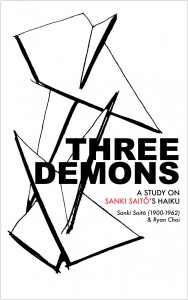
Three Demons: A Study on Sanki Saitō’s Haiku by Sanki Saitō, translated from the Japanese by Ryan Choi, Open Letter, 2024
Review by Henry Gifford
The contents of Ryan Choi’s Three Demons: A Study on Sanki Saitō’s Haiku don’t quite look like haiku. Whatever variations the form has seen over its roughly five hundred years, it remains an art of concision—but Choi’s inventive translation of Sanki Saitō is composed of eight long poems which he calls “series,” each integrated less by subject than appearance. One is laid out like a grid, while another sways smoothly across the pages, bearing some resemblance to a river. The content, too, is unusual for the genre. Though much of the book is devoted to the natural, seasonal imagery of traditional Japanese poetry, Choi foregrounds the poet’s departures; the first two lines of the book read “machine / guns.”
The divergence in content is Saitō’s. The twentieth-century Japanese poet was his own mentor, his own tradition, and an eminent post-war writer and editor. His works speak of goldfish trapped under a sheet of ice, of horses always “mired” in mud. And just as the legacy of World War II is all over Saitō’s work, it also thoroughly permeates Choi’s study. Much of Three Demons is suggestive of an elegy for a young soldier—perhaps a representation of youth everywhere, or of Japan. Twice in the collection we come across the following italicized words (divided differently in each case): “Sand mixed atomic dust billows—fountains, spring.” Nothing could better capture the poisonous irruption of nuclear warfare. Sand, fountains, and spring could have once made for a peaceful haiku, but no longer.
The divergences in form, however, are Choi’s wondrous contribution. I’ve never heard of a haiku translator who didn’t express a hopelessness in their endeavor; haiku’s concision is made possible by the Japanese language, but also by specific cultural associations, whereby, for example, a cuckoo’s song will always evoke a melancholy dusk (per Harold G. Henderson’s An Introduction to Haiku). This allows for a poetry of recognition, implication, and ambiguity. Choi’s effort to reproduce such effects have resulted in the unusual appearance of his translations. The layout of each “series” gives it a distinct, albeit unspecifiable, character, and allows for an interweaving and interaction between sequentially distant but physically close lines (by way of pages with multiple columns). A similar effect comes from the sporadic italicization, but most effective of all is Choi’s repetition of poems and images, both within and between each series. The repetitions produce a bittersweet frisson of recognition for images that may at first have been unfamiliar, and in that recognition they do what haiku are said to do: transforming contexts both old and new, until one gets the sense of a significant, ineffable totality.

The Trial of Anna Thalberg by Eduardo Sangarcía, translated from the Spanish by Elizabeth Bryer, Restless Books, 2024
Review by Henry Gifford
At the height of the Thirty Years’ War in the early seventeenth century, a series of witch trials began in the Bishopric of Würzburg. Adding to the brutality of one of Europe’s bloodiest eras, representatives of the Catholic Church executed nine hundred men and women for witchcraft. The Trial of Anna Thalberg, by Mexican academic Eduardo Sangarcía and translated by Elizabeth Bryer, narrates the last weeks of one of these victims’ lives, from her arrest to her execution—which, despite the pretenses of the word trial, turns out to have been a certainty all along.
With Anna’s arrest, we enter a nightmare shared by the entire bishopric, narrated with the restless, free-associative logic of dreams, and replete with a sense of demonic evil that is, to some extent, real. By the end of the novel, most of its characters have identified that evil with someone around them: it is the witch Anna, or her accuser Gerda, or her torturer Vogel, or a whole cabal of witches in hiding. It would be easier for Sangarcía and his reader to join in on these accusations; it does initially seem that Anna’s brutal torture is simply the result of xenophobia and misogyny—but then we wonder if we ought to instead blame her culture’s religious zealotry, or finally the cynical power machinations of Vogel, who doesn’t even believe that anyone believes in witches. What Sangarcía demonstrates is that all of these factors work in concert, reinforcing one another until it is inevitable that an innocent woman be burned alive.
It is the trial’s foregone conclusion that allows the novel’s style to function; the prose moves through time with the same fluidity as that between its shifts of perspective, providing an apt flooding of what is, what has been, and what will be—again like a nightmare. The sight of a forest path, for example, reminds Anna’s husband Klaus of what his father once told him there, and we briefly follow him into that memory. The parish priest’s recollection of a previous execution leads to the anticipation of the one to come: “Böhm was condemned to death and burned alive on the pyre, as will be done to Anna.” This intermingling makes palpable the sense that Anna’s story has only one possible end; the events, once set in motion, have only to pass, and there is nothing anyone can do to stop them.

A Muzzle For Witches by Dubravka Ugrešić, translated from the Croatian by Ellen Elias-Bursać, Open Letter, 2024
Review by Christopher Higgs
For the past forty years, discerning readers and writers have widely regarded Dubravka Ugrešić as a bold, experimental thinker and artist, committed to rendering her politically-infused compositions in avant-garde modes. Winner of the prestigious Neustadt International Prize for Literature in 2016, Ugrešić’s work has long grappled with identity, most notably at the intersection of gender, genre, and nationality. In A Muzzle For Witches, her final book, Ugrešić offers a rare opportunity for readers to eavesdrop on a fascinating conversation between the author and the literary critic Merima Omeragić.
Like each of her previous works, A Muzzle For Witches refuses to conform to expectations. In the acknowledgements, Ugrešić explains: “The editor and I gave up on categorizing this book in terms of genre—is this a conversation, an interview, or merely an unfettered monologue of mine?” In fact, it seems to perform all of those categories, and beyond; sometimes it reads like a philosophical treatise or a manifesto for a woman writer in exile, and other times it reads like a memoir, with Ugrešić reflecting on her life in former Yugoslavia turned Croatia, the factors that contributed to her exile in Amsterdam, and the literary art she had created up until her untimely death last year.
From the opening story, where Ugrešić tells Omeragić about how she suffered bullying as a child from kids who saw her as ethnically other—“a Bulgaria girl”—and how those experiences directly contributed to her sustained feelings of marginalization throughout her life, to the final story where she elaborates on her concept of “the melancholy of vanishing,” A Muzzle For Witches relentlessly examines what it means to exist in a world full of categories, without ever really belonging to any of them. Throughout this life of resisting labels, the only exception may be her gender, of which Ugrešić takes a passionate, second-wave approach—challenging patriarchal European societies and the ways they alienate and silence women who dare question the order of things.
New readers of Ugrešić’s writing will find in A Muzzle For Witches a brilliant framework for entry, while longtime readers will discover a treasure trove of context, serving to reframe and enrich their experiences with her tremendous oeuvre.
Fani Avramopoulou is a writer living in Philadelphia with roots in Baltimore and Athens, Greece. She has taught writing at Temple University, in middle school classrooms, and in virtual space. She is an editor for Essay Press.
Henry Gifford is a freelance copy editor and translator.
Christopher Higgs lives in Los Angeles. He teaches narrative theory and technique at California State University Northridge, and he still loves his first novel, The Complete Works of Marvin K. Mooney (2010, Sator Press/Two Dollar Radio).
*****
Read more on the Asymptote blog:

